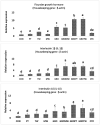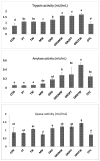Effect of Four Functional Feed Additives on Growth, Serum Biochemistry, Antioxidant Capacity, Gene Expressions, Histomorphology, Digestive Enzyme Activities and Disease Resistance in Juvenile Olive Flounder, Paralichthys olivaceus
- PMID: 37627488
- PMCID: PMC10451338
- DOI: 10.3390/antiox12081494
Effect of Four Functional Feed Additives on Growth, Serum Biochemistry, Antioxidant Capacity, Gene Expressions, Histomorphology, Digestive Enzyme Activities and Disease Resistance in Juvenile Olive Flounder, Paralichthys olivaceus
Abstract
An 8-week feeding trial was executed to evaluate the efficacy of four functional feed additives in replacing antibiotics in juvenile olive flounder, Paralichthys olivaceus, fed with a low-fish-meal diet. A basal diet without feed additives was used as a control (CON); other diets were formulated by supplementing 0.50% taurine (TW), 0.30% peptide (PT), 0.23% mineral water (MW), 0.35% yeast-extracted nucleotides (GRO), 0.35% GRO + 0.50% taurine (GROTW), 0.35% GRO + 0.30% peptide (GROPT) and 0.35% GRO + 0.23% mineral water (GROMW) into the basal diet; in addition, one diet was supplemented with oxytetracycline (OTC) at 0.5% as a positive control. Triplicate groups of 25 fish with an average weight of 5.15 ± 0.06 g (mean ± SD) were fed one of the nine experimental diets. At the end of the feeding trial, the weight gain, specific growth rate and protein efficiency ratio of fish fed the GRO, GROMW, GROPT and GROTW diets were significantly higher than those of fish fed the CON diet (p < 0.05). The feed efficiency of fish fed the GRO, GROMW, GROPT and GROTW diets was significantly higher than that of fish fed the TW and OTC diets. However, the survival, hepatosomatic index, viscerosomatic index and condition factor of fish, as well as their whole-body proximate composition, were not significantly affected by the experimental diets (p > 0.05). The serum glutamic pyruvic transaminase of fish fed the GROPT diet was significantly lower than that of fish fed the CON diet. However, glutamic oxaloacetic transaminase, glucose and total protein were not significantly affected by the experimental diets (p > 0.05). The serum superoxide dismutase activity of fish fed the PT, TW, GRO, GROMW, GROPT and GROTW diets was significantly higher than that of fish fed the CON diet. The lysozyme activity of fish fed the PT, GRO, GROMW, GROPT and GROTW diets was significantly higher than that of fish fed the CON and OTC diets. The myeloperoxidase activity of fish fed the TW, GRO, GROMW, GROPT and GROTW diets was significantly higher than that of fish fed the CON, PT and MW diets (p < 0.05). The flounder growth hormone gene expression of fish fed the TW, GRO, GROMW, GROPT, GROTW and OTC diets was significantly higher than that of fish fed the CON, PT and MW diets (p < 0.05). The interleukin 1β and interleukin 10 gene expressions of fish fed the GRO, GROMW, GROPT and GROTW diets were significantly higher than those of fish fed the CON, PT, TW and MW diets (p < 0.05). Intestinal histology showed a significantly higher villi length for fish fed the GRO, GROMW, GROPT and GROTW diets compared to that of fish fed the CON diet (p < 0.05). Digestive enzyme activities such as trypsin activity were significantly higher in fish fed the GROMW, GROPT and GROTW diets than those in the rest of the diet groups (p < 0.05). Amylase activity in fish fed the MW, GRO, GROMW, GROPT, GROTW and OTC diets was significantly higher than that of fish fed the PT, TW and CON diets (p < 0.05). On the other hand, the lipase activity of fish fed the TW, GRO, GROMW, GROPT and GROTW diets was significantly higher than that of fish fed the CON, PT, MW and OTC diets (p < 0.05). The cumulative survival rate of fish fed the PT, GROTW, GROPT and GROMW diets was significantly higher than that of fish fed the CON, TW and MW diets after thirteen days of the challenge testing. Overall, the results demonstrate that the GRO, GROMW, GROPT and GROTW diets could be beneficial feed additives to replace antibiotics in juvenile olive flounder fed low-fish-meal diets.
Keywords: antioxidant defense; disease resistance; gene expressions; growth performance; histology; mineral water; olive flounder; peptide; taurine; yeast-extracted nucleotide.
Conflict of interest statement
The authors declare that the research was conducted in the absence of any commercial or financial relationships that could be construed as potential conflicts of interest.
Figures




Similar articles
-
Evaluation of Dietary Probiotic Bacteria and Processed Yeast (GroPro-Aqua) as the Alternative of Antibiotics in Juvenile Olive Flounder Paralichthys olivaceus.Antibiotics (Basel). 2022 Jan 19;11(2):129. doi: 10.3390/antibiotics11020129. Antibiotics (Basel). 2022. PMID: 35203732 Free PMC article.
-
Evaluation of three fish-derived probiotic bacteria replacing antibiotics on growth, immunity, gut morphology and disease resistance in juvenile olive flounder Paralichthys olivaceus fed reduced fish meal diets.Front Nutr. 2025 Feb 13;12:1519140. doi: 10.3389/fnut.2025.1519140. eCollection 2025. Front Nutr. 2025. PMID: 40018274 Free PMC article.
-
Evaluation of Gamma-Aminobutyric Acid (GABA) as a Functional Feed Ingredient on Growth Performance, Immune Enhancement, and Disease Resistance in Olive Flounder (Paralichthys olivaceus) under High Stocking Density.Antioxidants (Basel). 2024 May 25;13(6):647. doi: 10.3390/antiox13060647. Antioxidants (Basel). 2024. PMID: 38929086 Free PMC article.
-
Fish Meal Substitution Effects with the Combined Animal Proteins in the Feeds of Olive Flounder (Paralichthys olivaceus) on Growth Performance, Feed Availability, and Disease Resistance against Streptococcus iniae.Animals (Basel). 2024 Apr 11;14(8):1162. doi: 10.3390/ani14081162. Animals (Basel). 2024. PMID: 38672310 Free PMC article.
-
Inclusion Effect of Various Levels of Jack Mackerel Meal in Olive Flounder (Paralichthys olivaceus) Diets Substituting 50% Fish Meal with Duck By-Product Meal on Growth and Feed Utilization.Animals (Basel). 2024 Jul 26;14(15):2184. doi: 10.3390/ani14152184. Animals (Basel). 2024. PMID: 39123711 Free PMC article.
Cited by
-
Insect-Antioxidants Symbiotic Nexus-Pathway for Sustainable and Resilient Aquaculture: A Case Study for Evaluating Koi Carp Growth and Oxidative Stress Status.Antioxidants (Basel). 2025 Mar 21;14(4):371. doi: 10.3390/antiox14040371. Antioxidants (Basel). 2025. PMID: 40298621 Free PMC article.
-
Nutritional impact of nano zeolite, probiotic, and fatty acids as feed additives on health status of Nile tilapia (Oreochromis niloticus).Sci Rep. 2023 Dec 20;13(1):22740. doi: 10.1038/s41598-023-50034-2. Sci Rep. 2023. PMID: 38123621 Free PMC article.
-
The Enhanced Growth Performance and Antioxidant Capacity of Juvenile Procambarus clarkii Fed with Microbial Antioxidants.Antioxidants (Basel). 2025 Jan 23;14(2):135. doi: 10.3390/antiox14020135. Antioxidants (Basel). 2025. PMID: 40002322 Free PMC article.
-
The Role of Functional Feed in Modulating Fish Gut Microbiome to Enhance Resistance Against Aquaculture Pathogens.Probiotics Antimicrob Proteins. 2025 Jul 22. doi: 10.1007/s12602-025-10660-w. Online ahead of print. Probiotics Antimicrob Proteins. 2025. PMID: 40694305 Review.
References
-
- Food and Agriculture Organization (FAO) Global Aquaculture Production (Online Query) 2020. [(accessed on 7 June 2023)]. Available online: http://www.fao.org/fishery/statistics/global-aquaculture-production/en.
-
- Galkanda-Arachchige H.S., Wilson A.E., Davis D.A. Success of fishmeal replacement through poultry by-product meal in aquaculture feed formulations: A meta-analysis. Rev. Aquacult. 2020;12:1624–1636. doi: 10.1111/raq.12401. - DOI
-
- Young N., Brattland C., Digiovanni C., Hersoug B., Johnsen J.P., Karlsen K.M., Kvalvik I., Olofsson E., Simonsen K., Solås A.M., et al. Limitations to growth: Social-ecological challenges to aquaculture development in five wealthy nations. Mar. Policy. 2019;104:216–224.
-
- Bush S.R., Marschke M.J. Making social sense of aquaculture transitions. Ecol. Soc. 2014;19:3. doi: 10.5751/ES-06677-190350. - DOI
-
- Young N., Matthews R. The Aquaculture Controversy in Canada: Activism, Policy, and Contested Science. UBC Press; Vancouver, BC, Canada: 2011.
Grants and funding
LinkOut - more resources
Full Text Sources
Research Materials

